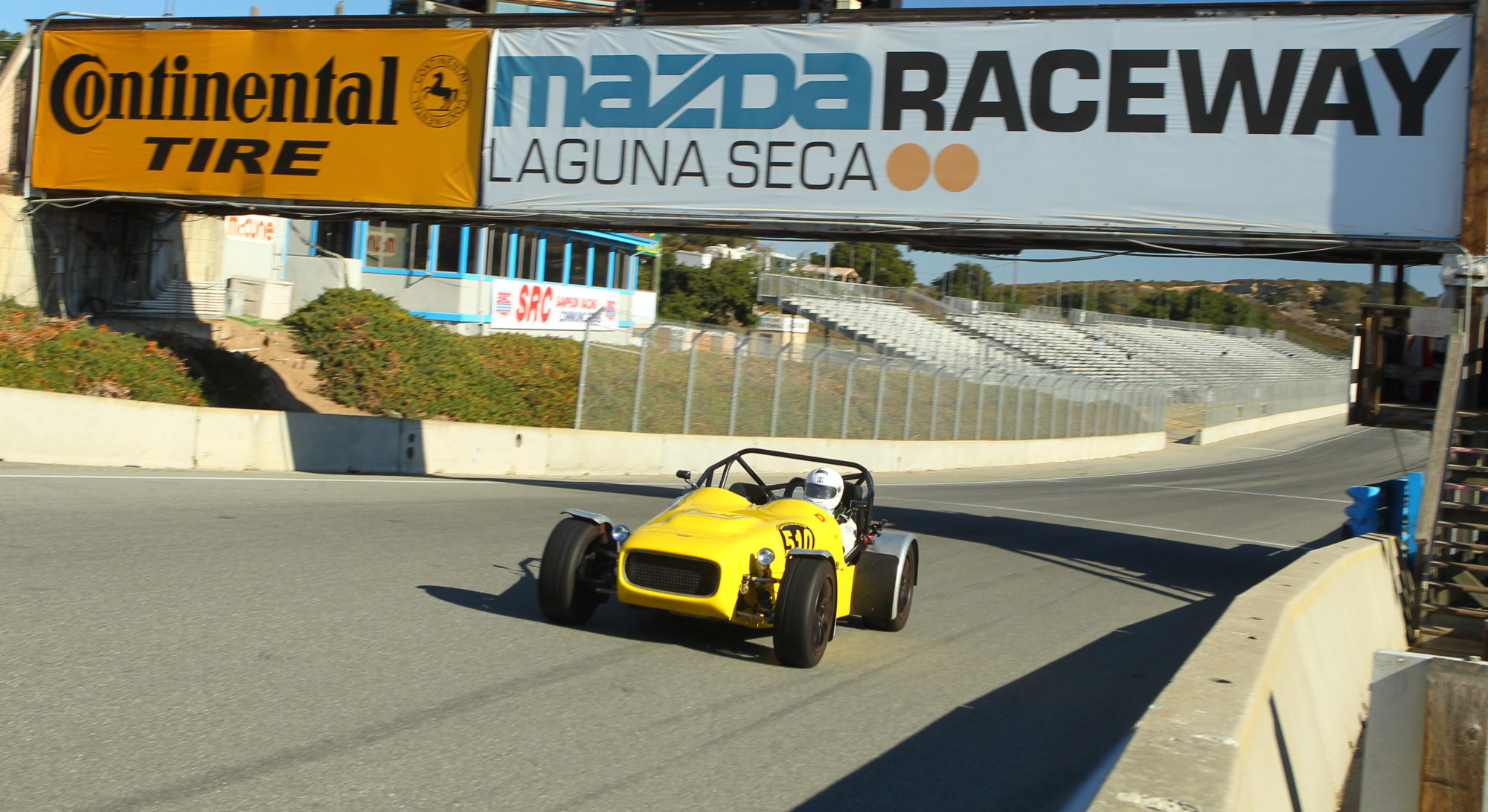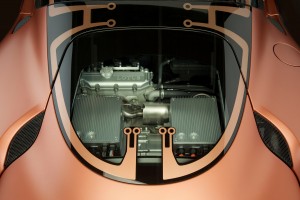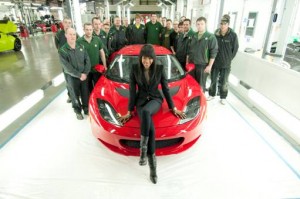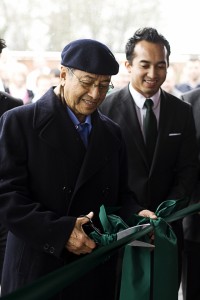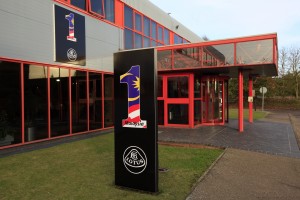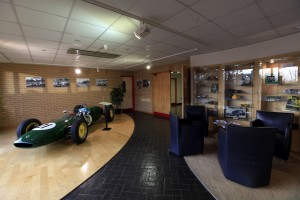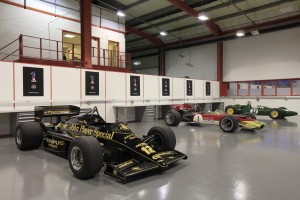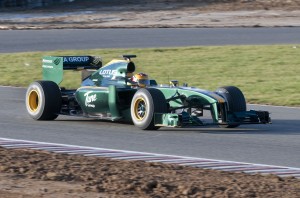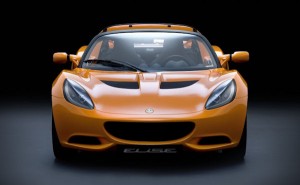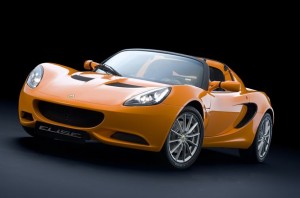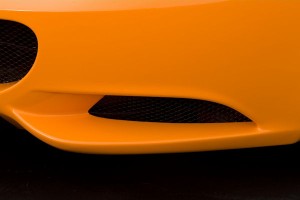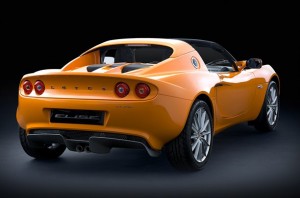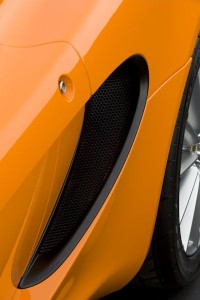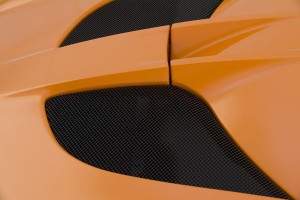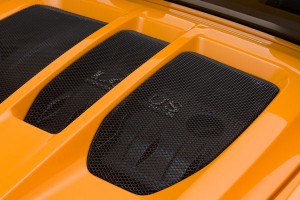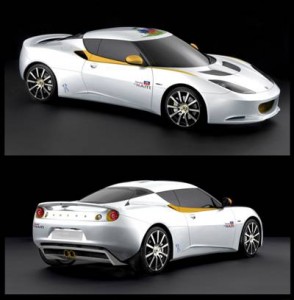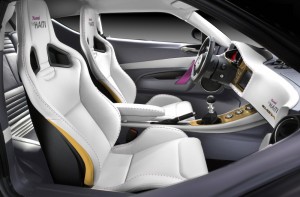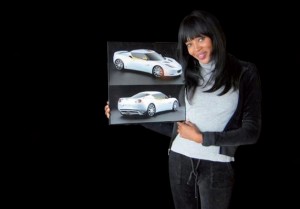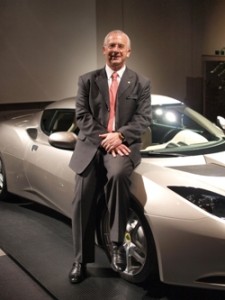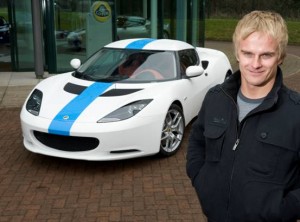The 80th International Geneva Motor Show sees Lotus Engineering unveil the Lotus Evora 414E Hybrid concept, a high performance technology demonstrator with a plug-in series hybrid drive system and new technologies for enhanced driver involvement.
- 0-60 mph/97 kph in under 4 seconds
- Total hybrid range of over 300 miles/483 kilometres
- Eco mode or Sports mode featuring realistic 7 speed paddle shift with energy recuperation
- HALOsonic Internal and External Electronic Sound Synthesis
- Torque vectoring for improved dynamic stability
- Integrated glass roof and engine cover and interior concept from Lotus Design
The Lotus Evora 414E Hybrid, so-named because this latest environmentally-focused technology demonstrator from Lotus Engineering produces 414 PS (306 kW) of power, promises breathtaking performance from a highly efficient propulsion system. The concept showcases new developments in plug-in, range-extended electric propulsion, new electronic technologies to enhance driver involvement, the adaptability of the Lotus Versatile Vehicle Architecture (VVA) that underpins the Evora 414E Hybrid and a dramatic new roof system and interior concept from Lotus Design. Through all of these aspects it ultimately demonstrates the exceptional ability of Lotus Engineering to integrate and develop advanced technologies for exciting, efficient, high performance niche vehicles.
The range extended electric drive of the Evora 414E Hybrid consists of two electric motors driving each of the rear wheels independently via single speed geartrain, integrated into a common transmission housing, thus enabling torque vectoring for stability control of the vehicle. Electrical power is stored in a lithium polymer battery pack optimised for energy density, efficiency and high power demand, mounted in the centre of the vehicle for stability and safety. Additional range is provided by the Lotus Range Extender engine, an optimised 1.2 litre, three-cylinder engine, designed specifically for series hybrid vehicles. The drivetrain is designed to combine astonishing performance with efficient, low emissions driving.
Driver involvement is enhanced by the incorporation of HALOsonic Internal and External Electronic Sound Synthesis technologies from Lotus and Harman International, which provide sound contouring within the cabin and improve pedestrian safety outside the vehicle. Integrated with the HALOsonic technology, the Evora 414E Hybrid also showcases a brand new technology from Lotus Engineering, a sports mode that simulates a 7 speed, paddle shift transmission that combines exceptional driver involvement for a hybrid sports car and optimised energy recuperation.
The Evora 414E Hybrid has been designed to highlight Lotus’ innovative electric and hybrid vehicle technology without distracting from the pure sportscar character of the Evora. The solution is innovative, instantly recognizable, beautiful and sporty. It demonstrates Lotus DNA.
Dr Robert Hentschel, Director of Lotus Engineering said: “Innovation has always been at the heart of Lotus and is needed now more than ever. The Evora 414E Hybrid is the perfect demonstration of Lotus Engineering’s core competencies: lightweight architectures, efficient performance, electrical and electronics integration and driving dynamics. The technology demonstrator represents an encapsulation of the advanced technologies that Lotus Engineering continues to develop to overcome the current environmental challenges facing the automotive industry and showcases the future direction that the sector is taking and why Lotus Engineering is perfectly placed to lead the technological development in this area.”
The Drivetrain
For the Lotus Evora 414E Hybrid, Lotus Engineering has developed a highly efficient, high performance drivetrain system consisting of twin motors each limited to providing 152 kW (207 PS/204 hp) of power and 400 Nm (295 lbft) of torque to each wheel via independent, single speed, reduction transmissions integrated into a single housing, enabling torque vectoring dynamic control of the vehicle.
The vehicle energy storage system is made up of the latest Lithium Polymer battery chemistry providing 17 kWH energy storage capacity. The battery pack is optimised for energy density, efficiency and high power demand, with over 100 kW discharge capability.
The Lotus Range Extender engine provides 35 kW (48 PS/47 hp) of power at 3,500 rpm via the integrated electrical generator and features an innovative architecture comprising an aluminium monoblock construction, integrating the cylinder block, cylinder head and exhaust manifold in one casting. This results in reduced engine mass, assembly costs, package size and improved emissions and engine durability. The engine uses an optimised two-valve, port-fuel injection combustion system to reduce cost and mass and can be operated on alcohol-based fuels and/or gasoline. The generator converts mechanical energy to electrical energy to replenish the battery pack charge and provides additional vehicle range in a small light weight package. The generator is also used as a motor to start the range extender engine. The low mass of the range extender unit (85 kg) and compact package makes it ideal for the series hybrid drivetrain in the Evora 414E Hybird.
All the operation and management of the range extender engine, the power management of the batteries and motor control are controlled by Lotus’ electronic control units and software systems. Full energy management of all the operating systems is the key to maximising performance and operation while minimising energy consumption and CO2 emissions.
For everyday commuting journeys, up to 35 miles can be travelled using battery power. The battery can be charged overnight using a conventional domestic mains supply through a socket concealed by the rear number plate. This permits the vehicle to operate with zero tailpipe emissions. For longer journeys, exceeding the battery capacity, the highly efficient range extender engine is used as a generator to supply the motor with electrical power and top up the battery.
Lotus has used its own vehicle simulation tools to determine the size, capacity, power and performance of all the components in the drivetrain system to optimise the system operation. Overall this is far more energy efficient, weight efficient and cost effective than fitting the vehicle with a larger and more expensive battery, which for the majority of short journeys is a redundant weight, which increases energy requirements. With regard to the total lifetime CO2 emissions of the vehicle, including the energy required to manufacture and run it, the range extender solution has a lower overall CO2 footprint than a fully electric car of comparable performance and operating range running with a larger battery.
The Package
The Lotus Evora 414E Hybrid structure is the same award-winning, versatile vehicle architecture used on the Lotus Evora. The low volume architecture was designed with the upmost flexibility in mind. The Evora 414E Hybrid is a perfect example of how to integrate a compact packaged drivetrain, with excellent performance and range, while using this underpinning. The complete chassis has remained unchanged from the Evora which maintains the structural integrity and strength performance of the original car.
The structure progresses the Lotus ‘bonded and riveted’ technology with new and unique extrusions and folded panels, whilst providing production build modularity and lower cost repairs. The chassis has been designed for scalability so that it can be extended in width, length and height. The strength and stiffness of the low volume VVA chassis can be modified cost effectively by varying the wall thickness of the extrusions, without altering the exterior dimensions. The ability to lengthen or shorten extrusions with the option to tailor the chassis stiffness vastly increases the number of vehicles that can be developed from this vehicle architecture.
Driving Dynamics
The Lotus Evora 414E Hybrid offers exhilarating, all-round dynamic performance and takes advantage of Lotus developed torque vectoring dynamics. Torque vectoring, which is the capacity to generate different torques at each of the driving wheels, is particularly suited to electric vehicles and significantly reduces the conflict between stability and response.
A key benefit of separate motors to drive each rear wheel individually is that this facilitates a much higher level of vehicle dynamics control. Driving the wheels with different levels of torque can not only generate all the capabilities of a conventional ESP system using energy regeneration as opposed to brake application, but it can also actively drive each wheel forward at different rates, producing a turning moment at the rear of the vehicle in addition to the steering input.
This can be used to enhance low speed manoeuvrability and ease of parking but can also be used to produce a much greater level of straight line high speed stability. Incorporating lateral sensors the system also provides stability control capabilities and levels of steering response normally only associated with heavy and expensive rear steer systems. This can provide automatic correction of both understeer and oversteer characteristics. In addition, the standard method to provide high speed stability of designing the rear wheels to toe-in is not required as the torque vectoring system automatically provides this stability control, with toe-in increasing rolling resistance, lowering fuel economy and increasing tyre wear. Lotus‘ long history of active suspension control provides the core capability to develop this technology and provides extraordinary driving pleasure on the Evora 414E Hybrid.
Driver Interaction
The Evora 414E Hybrid provides less of a psychological step change for people familiar with high performance cars compared to other electric and hybrid sports cars. The car has a simulated paddle shift gear change offering ultra quick gear changes reminiscent of a dual clutch transmission, while actually single speed. This enhances the driver interaction with the vehicle and provides a driving experience similar to current internal combustion engine high performance sports cars. The Evora 414E Hybrid uses a column mounted paddle shift to simulate the gear change and a synthesised engine sound changes frequency with virtual gear selection. The drive torque is also modulated to simulate a physical feeling of a gearshift jolt.
The virtual gearshift simulation, like a conventional gearbox, is used to change the driving characteristics and response of the vehicle. The most significant aspect that this offers the driver is the ability to control the vehicle deceleration by simulating engine braking through a virtual downshift in gears. Unlike true engine braking, the Lotus system does not dissipate the energy of the moving vehicle through internal engine friction but uses the electric motors to regenerate the energy back into the battery. While many electric and hybrid vehicles provide engine braking, this is generally at a fixed rate or preselected rate. In some driving situations this can either be too aggressive, slowing the vehicle unnecessarily, or too light, requiring additional braking application. The Lotus system effectively allows the driver to select the appropriate level of regeneration by simulating stepping down by one, two or even three gears. The simulation of engine braking through both the gear noise change and the retardation of the vehicle is fully intuitive to a driver familiar with a conventional gearbox. The simulated gearchange capability can be selected for greater driving involvement or switched off for more relaxed driving.
The Evora 414E Hybrid uses the Lotus Engineering and Harman International developed HALOsonic suite of noise solutions. The first of which is Electronic Sound Synthesis. This generates engine sounds inside the vehicle through the audio system where it provides an exciting sports sound in line with the brand and nature of the vehicle together with a high level of driver feedback in an intuitive manner. In addition, it also generates sound on the outside of the vehicle through speakers mounted at the front and rear to provide a warning to increase pedestrian safety, which is especially important for electric and hybrid vehicles which can be difficult to hear at slower speeds.
There are four driver selectable engine sounds currently on the vehicle, two of which have been designed to have characteristics of a multi-cylinder conventional V6 and V12 engine. There is also a futuristic sound and a combination of a conventional engine and a futuristic sound, enhancing the brand identity of the vehicle as a step forward in electric vehicle design.
The addition of this Lotus patented simulated gearshift concept not only provides for an exciting and involving driving experience that customers would expect from a Lotus, but also enhances the driver’s control of the vehicle while providing the capability for more efficient operation through a greater use of energy regeneration.
The Design
The distinctive colour scheme and ‘floating’ roof have been carefully designed to accent the cars electric vehicle technology whilst complementing the iconic lines of the Evora.
Copper, a colour often associated with electrical systems, has been chosen for the car’s exterior and interior. A contemporary satin finish paint is complemented by electrical circuit inspired graphics that highlight the car’s key feature lines and the unique glazed roof panel. The newly extended glazed zone integrates seamlessly with the existing forms of the Evora whilst showcasing the key components behind the hybrid and electric vehicle technology.
The signature copper theme is consistently carried throughout the car from the dramatic seat stripes and instrument panel inserts to the copper callipers that nestle behind the carbon grey forged wheels. Inside the cabin a sense of quality and richness has been created by carefully juxtaposing the different tactile qualities intrinsic to leather, Alcantara and metal.
[press release from Lotus]
